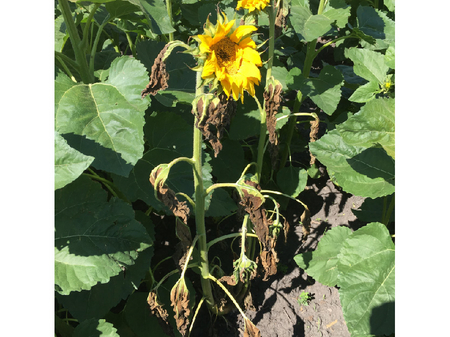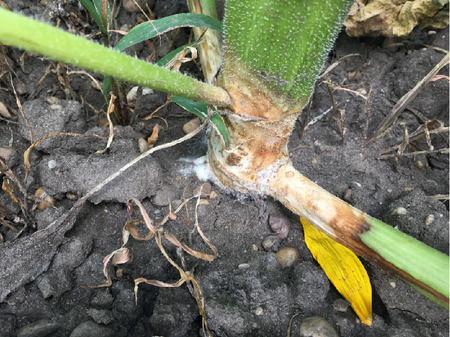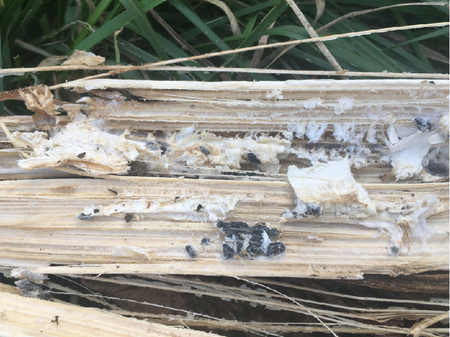Sclerotinia disease of sunflower
Sclerotinia sclerotiorum
Damage symptoms
Affected plants begin to wilt, leaves and flower baskets hang limply down the stems. At the base of the stem, starting on one half of the stem and later extending around the stem, a light brown to whitish lightening develops. Such whitening may also occur along the stem. These symptoms give rise to the name "white-stemmed sunflower."
The plants eventually wither and stand rigidly in the stand. The affected tissue is bleached and fibrous. The pith tissue is destroyed and the stems become hollow. If the stem is cut open lengthwise, black fungal survival structures (= sclerotia) up to 2 cm in size and sometimes even larger are found inside the stem, and occasionally a white, cotton-wool-like network of fungal threads (= mycelium). In moist, warm weather, the mycelium may also be formed on the outside of stems in association with sclerotia sitting on top.
The fungus can also attack the roots, leaves and flower baskets of sunflower plants. When the baskets are infested, light brown, watery spots initially appear on their backs or between the flowers and rapidly enlarge. Eventually, the entire basket dries out and takes on a skeletonized appearance. In some cases, a white mycelium and sclerotia are formed between the flowers/seeds. The seeds subsequently fall prematurely from the flower baskets.



Propagation and transmission
Sclerotinia sclerotiorum forms 5 to 20 mm large and sometimes even larger sclerotia, with the help of which the fungus can survive in the soil, on infested plant remains or on perennial weeds. In the soil, the survival structures of the fungus can remain viable for up to ten years.
The sclerotia, which are located near the soil surface, begin to germinate in the spring. These germinate either directly with mycelium, which can penetrate into the plants via the roots or the root neck, or from the sclerotia grow one to a few centimeters large, stemmed and cup-shaped fruiting bodies (= apothecia) with spores (= ascospores) serving for reproduction. For the germination of the sclerotia, temperatures between 6 and 10 °C must prevail. Shading of the sclerotia and moist soil are optimal for germination.
The formed ascospores are thrown off the fruiting bodies and spread with the wind. These can infect plants through weakened tissues and/or wounds. Infections take place in cool and damp weather. The optimum temperature for fungal growth is 20°C, but the fungus can still grow at 0°C.
In addition to spreading independently, the fungus can also be transmitted through seeds by directly infecting seeds with mycelium or by contaminating seeds with sclerotia.
Economic importance
On average, yield reductions of 10 to 20% are observed, but in case of very severe infestation, total failures may occur. Furthermore, seed quality is impaired, i.e. the oil content is reduced.
In addition to sunflower, this pest is also economically important for canola, field bean, soybean, pea, alfalfa and various vegetable crops.
Prevention and control
- Use of healthy seed
- Maintain a minimum four-year (preferably six-year) crop rotation, paying attention to the susceptibility of previous crops. Low susceptible are for example: Cereals, corn, beets and potatoes
- Control weeds, as they are potential host plants.
- Crush plant residues after harvesting and bag them to a depth of at least 10 cm
Last updated: 19.01.2022
automatically translated